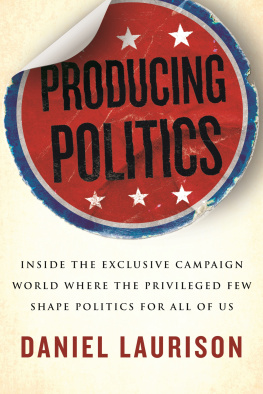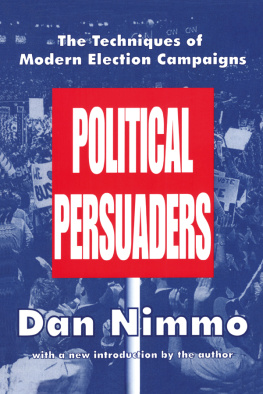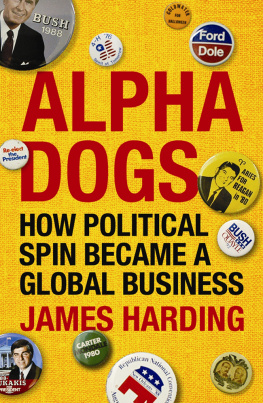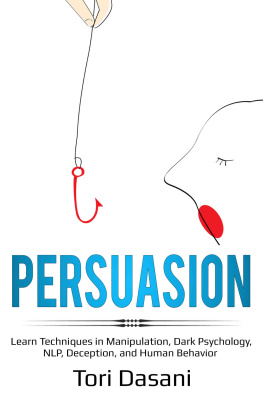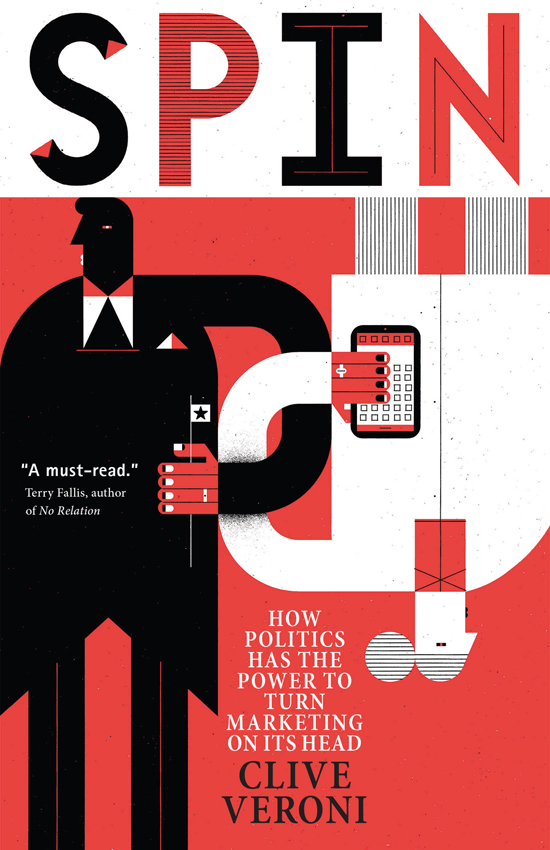PRAISE FOR CLIVE VERONI AND SPIN:
Clive Veroni recasts the rules for marketing and branding in the digital age a smart, entertaining romp lush with insight and example. Read it and reap.
William Thorsell, Editor in chief,
Globe and Mail 19891999
In an approachable, entertaining, highly readable manner, Clive Veroni takes us into the world of tribal consumers, big data, open branding, permission marketing, and the rise of individualized targeting. As such he takes us into the world of the future in political and commercial marketing campaigns. Enjoy the read, but ponder the implications!
Dr. Alan C. Middleton, Executive Director,
Schulich Executive Education Centre (SEEC)
SPIN
HOW
POLITICS
HAS THE
POWER TO
TURN
MARKETING
ON ITS HEAD
CLIVE VERONI
Copyright 2014 Clive Veroni
All rights reserved. No part of this publication may be reproduced or transmitted in any form or by any means, electronic or mechanical, including photocopying, recording, or any information storage and retrieval system, without permission in writing from the publisher.
Distribution of this electronic edition via the Internet or any other means without the permission of the publisher is illegal. Please do not participate in electronic piracy of copyrighted material; purchase only authorized electronic editions. We appreciate your support of the authors rights.
This edition published in 2014 by
House of Anansi Press Inc.
110 Spadina Avenue, Suite 801
Toronto, ON, M5V 2K4
Tel. 416-363-4343
Fax 416-363-1017
www.houseofanansi.com
Library and Archives Canada Cataloguing in Publication
Veroni, Clive, 1956, author
Spin : how politics has the power to turn marketing on its head / by Clive Veroni.
Includes index. Issued in print and electronic formats.
ISBN 978-1-77089-317-7 (pbk.). ISBN 978-1-77089-318-4 (html)
1. Communication in marketing Political aspects. 2. Marketing
Political aspects. 3. Communication in politics. 4. Campaign management. I. Title.
HF5415.123V47 2014 658.802 C2014-902720-6
C2014-902721-4
Library of Congress Control Number: 2014938782
Jacket design: WAX
We acknowledge for their financial support of our publishing program the Canada Council for the Arts, the Ontario Arts Council, and the Government of Canada through the Canada Book Fund.
To my mother, Estelle Weynman, who constantly inspires with her open heart and curious mind.
INTRODUCTION
TILT SHIFT
Change. It was the one-word campaign strategy that propelled the most significant presidential contest in recent history. And the hundreds of thousands of supporters who gathered in Chicagos Grant Park, on a clear and unusually warm November night in 2008, had come to see that promise of change made manifest. They would not be disappointed. It appeared in the form of an African-American family stepping out from behind a blue door onto a blue-carpeted runway that stretched like a broad landing strip out into the pulsating crowd. As an announcer intoned, Ladies and gentlemen, the next first family of the United States of America, the Obamas appeared on stage, smiling unaffectedly, as the cheering throng raised their arms and voices in unison.
In rhythm to the thudding helicopters above, they chanted, Yes we can! Yes we can! A fluttering of American flags rippled above their heads. Children were hoisted onto the shoulders of parents to glimpse this moment that would be told and retold for years and generations to come. The lights from countless cellphone screens, held aloft, flickered amid the crowd. Strangers hugged one another. Oprah wept.
The brightly lit runway that extended dozens of feet into the crowd was the end point of a very long road. Some say it was a road that stretched back to Springfield, Illinois, where Obamas election journey began in February 2007; others say it reached back to the march on Washington almost fifty years earlier; and others go back further still, to the dusty trails where the struggle for emancipation began. What everyone can agree on, however, is that this moment represented a significant change in American political life. And the whole world was watching.
The whole world is watching was a chant that famously echoed through this same park and the streets of Chicago exactly forty years earlier, during the 1968 Democratic National Convention, when anti-war protesters, who had been corralled into Grant Park, flowed onto the streets following violent attacks from riot police and National Guardsmen, who outnumbered them two to one. It was one of the most raucous and divisive moments in the history of the Democratic Party. But on this balmy night, as Obama strode calmly towards the podium to deliver his victory speech, the party had reached an historic high point and a moment of galvanizing unity. It was evident in the mass of supporters that surged around the stage, undulating as a single body.
As the crowd shifted and swayed, what they did not notice was that another change was taking place, not on the stage above them but right beneath their feet. The socio-political landscape was shifting, almost imperceptibly, but in ways that would affect every voter and every consumer in America and beyond not just on this day but for years to come.
In the endless back-and-forth between swing states and swing voters that defines U.S. politics, the amplitude of this unseen change could not be measured in ballots cast or electoral votes won; it would be measured by a tectonic shift in the way marketers and political strategists seek to influence what we believe and how we behave.
For decades, there had been a one-way flow of knowledge that travelled from Madison Avenue to Washington. Now the tide was turning. For years political strategists had tapped into the creative brain trust of the advertising world to uncover new ways of reaching and persuading voters. This trend began in the 1960s, at the height of the Mad Men era. In fact, it began at approximately 9:50 p.m. on Labour Day, September 7, 1964. It was then, during an airing of the film David and Bathsheba , a 1950s toga epic starring Gregory Peck and Susan Hayward, on NBC s Monday Night at the Movies that a whole new kind of political ad aired on television, an ad that would change forever the nature of political advertising in America.
The commercial, known as Daisy Girl, shows a pretty little blond girl standing in a sun-filled field. While birds chirp sweetly in the background, we see her picking the petals off a daisy. As she does so, she counts, One, two, three, four... She gets the numbers mixed up a little, adding to the sense of innocence and perhaps bringing a smile to the viewer. Five, seven, six, six, eight, nine. When she gets to nine, however, the tone of the spot shifts dramatically. Suddenly we hear an echoing and sinister-sounding male voice going through a launch countdown. Ten, nine, eight... The girl looks up anxiously towards the sky. Seven, six, five... The frame freezes and the camera moves in for an extreme close-up. By the time the countdown has reached zero her pupil fills the screen. The scene then dissolves into a nuclear explosion.
As we see the bright flash and the mushroom cloud forming, we hear the voice of President Lyndon Johnson saying, These are the stakes to make a world in which all of Gods children can live or to go into the darkness. We must either love each other or we must die. An announcer then says, Vote for President Johnson on November 3.


